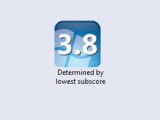The Windows Experience Index = Processor + Memory + Graphics + Gaming graphics + Primary hard disk. The calculations and operations per second, desktop and 3D graphics performance and the data transfer rate of the HDD all compose the overall Vista PC Score.
?The Windows Experience Index is a new feature built into Windows Vista. It is designed to help consumers understand how well Windows Vista and the software running on it will perform on a specific PC. The index achieves this by assessing the performance of the PC and assigning a score to it. The higher the score, the better the PC will perform. The overall PC performance is represented by the base score. The base score is derived from 5 sub-scores,? revealed Nick White, Microsoft Product Manager.
1 is the lowest possible score a Vista capable PC can receive. If it?s lower than 1, it doesn?t exist. No, I?m just kidding. And also, temporarily, the score cannot be over 5.9. Microsoft has promised to introduce overtime scores of 6 and above. But to avoid confusion, larger scores will simply add to the one already in existent without altering the 1 to 5.9 range.
Microsoft refers to the integer number of the base score as the Windows Experience Index level. Two machines with 4.2 and 4.9 score are both level 4 systems. Users can increase the Windows Experience Index base score either incrementally by upping their fractional score or by jumping levels with a massive hardware upgrade. The Windows Experience Index performance score is accessible via Control Panel ? Performance Information and Tools.
?Over time, we expect to introduce higher scale levels of 6 and beyond. This will be done approximately every 12-18 months, as new innovations in hardware become available. When new base scores are introduced, existing scores will not change (i.e. a PC with a base scored of 2.2 today will score a 2.2 in the new updated index, unless its components are upgraded),? stated White.
I recently got to talking with a friend. His system configuration and it is quite a configuration, only scored a total of 3.something on Vista. He was less than happy. So let?s discuss the example in the adjacent image. The processor scored 2.8, RAM got 4.5, Graphics 2.1, gaming graphics 3.1 and 4.7 for the primary hard disk. The overall Windows Experience Index base score is 2.1. Why? Because it is determined by the lowest subscore. In this case, the desktop performance for Windows Aero. What the Windows Experience Index illustrates is the fact that the performance of a system is only as high as its slowest component. The system in discussion requires an upgrade as the video memory bandwidth is keeping the score back.
The following are detailed descriptions of each of the base score levels, as delivered by Microsoft:
1.0 A base score of 1.0 is intended to reflect the minimum specification needed to run Windows Vista?. PCs that meet this level will run Windows Vista? in a basic, but acceptable manner. This is a ?catch all? level assigned to any machine that can realistically upgrade to Windows Vista? but won?t meet Level 2 specifications.
2.0 A base score of 2.0 represents the mainstream Windows Vista upgrade target system. This level of PC may run Windows Aero but users may see noticeable performance issues from time to time, especially on PCs with scores less than 2.5 and/or 64MB of graphics memory. Performance issues may also be noticeable when opening many application windows at the same time or when using very large monitors.
3.0 This level represents the value end of machines that will ship at the end of 2006 and into 2007. This is the lowest capability Windows Premium Logo PC that will ship with Windows Vista? pre-installed. Windows Vista will generally enable Aero automatically on level 3 machines. Aero will perform quite well on level 3 machines with single monitors. With dual monitors (especially larger than 1280x1024), users may see noticeable performance issues from time to time, especially on machines with scores less than 3.5 and/or 128MB of graphics memory.
4.0 This level of machine represents a very good performing machine. In late 2006 and 2007 machines at this level will be considered high end. All Windows Vista features will run well with snappy performance. HD playback and recording of one HD stream will work well. 3D games and other high-end 3D applications will run acceptably on Level 4 machines. Multi-tasking will be quite good on these machines (when an application makes use of this capability). Many mid to high level 4 PCs will have dual core CPUs.
5.0 This level of machine represents the highest end of the PC market ? gaming machines, high performance desktops, powerful media center systems and the like. Level 5 PCs will dramatically exceed the Windows Premium logo requirements. They will easily run Aero-Glass on multi-monitor systems at high resolution. First person shooters, multiple HD streams, video creation, high end multimedia applications are all characteristic scenarios of people who will be using Level 5 systems. As Level 6 machines are not defined yet, it is possible that the highest performance and capable Level 5 machines may be re-leveled as level 6 in the future (i.e. that may happen if the new hardware is evaluated before the index is updated with the new capabilities).
6.0 and beyond Base scores of 6.0 and higher are not defined yet. They will be defined when the time comes and new innovations in hardware allow new capabilities. From past experience, it is expected this will happen at a rate of once every 12-18 months.
Levels 1 and 2 are sufficient only to run windows Vista under the basic performances: IM, web, email, simple games ? Aero is out of the question. A level three machine will run Windows Vista Premium, Aero, standard definition TV and basic graphical games included. High-end desktops begin at level 4 ? high definition video, high resolution monitors and dual monitors. Level 5 corresponds to top end desktops and that is enough said.
While computing the base score ?the model logic is tolerant of one sub-score being below the threshold for a particular level by 0.1. For example, assume that in the above example, the memory score was 4.0 and the processor score 3.9. This would mean that the processor score would very marginally be the only item keeping the base score below level 4. The model addresses this issue by rounding up a single value that is below the next round level by 0.1,? White said.
To calculate the CPU subscore, Vista will evaluate:
1. Compression and decompression using the LZW compression algorithm. 2. Compression and decompression using the Windows Vista compression algorithm used for hibernation files, ReadyBoost and other features. 3. Encryption and decryption assessment 4. Computing hashes 5. Encoding of video
The Memory Score is a reflection of the bandwidth of moving data into and out of memory in mega bytes per second. This means that for 256 MB RAM, there will be a highest possible score of 1.0. For less than 500 MB - 2.0, 512 MB or less - 2.9, less than 704 MB - 3.5, less than 960 MB - 3.9 and less than 1.5 GB - 4.5.
The Graphics Score evaluates the video memory bandwidth on systems running Aero and playback Windows Media Video.
While the Disk Score is generally larger than 2.0 for modern disks, the Gaming Score corresponds to the number of frames per seconds, support for D3D 9, DX 9, WDDM drivers and support for Pixel Shader 3.0.

 14 DAY TRIAL //
14 DAY TRIAL // 

